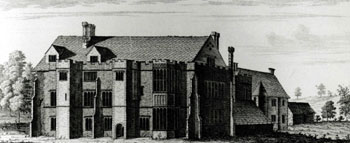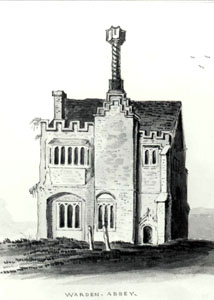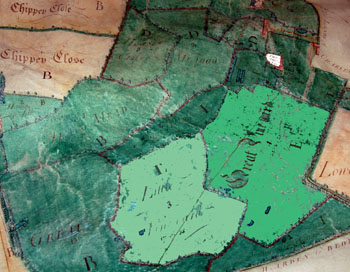Warden Abbey

Warden Abbey great seal
Warden Abbey was founded in or before 1135 by Walter Espec, Lord of the Manor of Old Warden; it was part of the Cistercian order. Espec had founded the great Cistercian abbey at Rievaulx in Yorkshire and he used monks from here to begin his foundation at Old Warden. King Stephen confirmed Espec's foundation in the first year of his reign, 1135. The cartulary for the abbey, i.e. an abstract of all the deeds affecting it, was published by Bedfordshire Historical Records Society as Volume XIII of their annual series in 1930. At some time between 1159 and 1181 Pope Alexander IV had to order the English clergy to excommunicate anyone who had done harm to the monks of Warden until they made recompense, suggesting that the foundation had made enemies locally.
The earliest name of the abbey was Saint Mary Sartis, the last element acknowledging that it was built on an assart, that is land which formed part of the unproductive land, or waste, of the manor. The abbey seems to have undergone a surge in its land holdings, through grants by wealthy patrons, towards the end of the 12th century.

Image of the The arms of Warden Abbey on a C15 roof boss in the north aisle of Ampthill parish church. Copyright M. Roberts.
By 1291 the abbey owned land, through grants by wealthy patrons, not only in Bedfordshire but in eastern counties too and these were valued about the same as the other great Bedfordshire Cistercian house at Woburn. The cartulary shows the abbey being given grants of land (sometimes at a rent or a sale for the full value) or income from land in the following places (with dates of the grants):
Bedfordshire
- Arlesey: land; before 1200;
- Aspley Guise: rent on land: 1274-1302;
- Astwick: 12 acres, a messuage and a croft: between 1200 and 1220;
- Bedford: 4 acres, , buildings east of Saint Cuthbert's church and rent of a stone built house by Bedford Bridge; between 1180 and 1200;
- Biggleswade, including Holme: 2 acres and 1 rood; between 1190 and 1220;
- Blunham, including Southmills: 7½ acres of land, 2 acres of meadow and a messuage and a rent; between 1200 and 1240;
- Cardington; 7 acres; before 1257
- Chicksands: land; before 1180;
- Clapham: lands: between 1190 and 1200;
- Clifton: 1 hide, 5½ acres, 2 roods, 1 messuage and crofts, rent of a glebe meadow and other land; between 1171 and 1379;
- Clophill: a cotland; between 1210 and 1220;
- Cople: Troclei Wood, 22 acres, 4 roods, 1 messuage and croft and other land; between 1160 and 1225;
- Dunton and Millow: 46 acres; between 1165 and 1220;
- Edworth: land; between 1200 and 1210;
- Eyeworth: a acre of land and a meadow; between 1200 and 1400;
- Flitwick, including Priestley: 3 acres, 2 hides,1 furlong and Bocokeseie pasture; before 1200 to 1210;
- Goldington and Aldwick: 55 acres, 4 butts and 5 roods, 3 roods of arable; 1½ acres of meadow, 2 messuages and other land including the mill at Risinghoe and land "at the bailey of the old Castle"; between 1170 and 1240;
- Haynes: a manor and land; between 1160 and 1322;
- Henlow including North Mills: Henlow Manor, 28 acres of arable, 4 acres of meadow and 6 roods of land; before 1190 to 1330;
- Houghton Conquest: land; between 1160 and 1200;
- Kempston: 33 acres in Kingsmead; 1136 to 1280;
- Maulden, including Withermere and Limbersey: 1 virgate and other land; before 1190 to 1262;
- Millbrook: 1 hide and ½ a virgate; before 1234;
- Milton Ernest: a mill; before 1200;
- Mogerhanger, including Chalton: 6 acres of land and rents; between 1230 and 1250;
- Northill, including Caldecote and Ickwell: 46 acres, 16½ roods, mills and land; before 1166 to 1242;
- Old Warden, including Hill: a rent, 110 acres, 3 roods of meadow, a furlong, pasture for 200 sheep, common over 80 acres, ½ a hide, 1 messuage and croft and other land; about 1154 to 1223;
- Pertenhall: land; between 1170 and 1190;
- Putnoe: 4 acres of arable, 1 acre of meadow, 2 virgates, a tenement, common of pasture and other land; between 1170 and 12200;
- Ravensden, including Tilwick: 17½ acres and 1½ virgates; 1180 to 1262;
- Renhold: 1 acre; between 1190 and 1210;
- Sandy, including Girtford, Stratford and Beeston: Cockswell Brade, pasture for 400 sheep, 2 virgates of land, 15 acres of meadow, a messuage and toft and other land; 1190 to 1249;
- Southill, including Broom and Stanford: 1 hide, 16 acres, 1 acre of arable, ½ an acre of meadow, a virgate, a messuage and croft, 2 tenements, other land and income from land; between 1170 and 1354;
- Stagsden, including Dilwick: 15½ virgates, a tenement and other land; 1200 to 1354;
- Steppingley: land held of Steppingley Manor; between 1290 and 1350;
- Stotfold: 5 acres; before 1257
Buckinghamshire
- Edlesborough: ½ a virgate; between 1190 and 1200;
- Wavendon: 1 acre; about 1223
Cambridgeshire
- Arrington: a messuage: between 1200 and 1210;
- Barham: 37 acres and other land; between 1200 and 1220;
- Barrington: a rent; between 1175 and 1190;
- Burrough Green: land; between 1200 and 1220;
- Croydon: 1 acre and a messuage; 1237 to 1287;
- Dullingham: 12 acres, 7 roods of meadow and ½ a virgate; between 1210 and 1225;
- Gamlingay: a messuage and 3 selions; about 1200;
- Swaffham Bulbeck: land; about 1210;
- Westley Waterless: land; between 1200 and 1220;
- Wratting: 10 acres; between 1180 and 1190
Hertfordshire
- Broadfield: 30 acres; 1160;
- Hinxworth: five acres and other land: between 1200 and 1210;
- Hitchin: rents; between 1190 and 1210;
- Odsey: land; about 1150 to 1200;
- Sandon: 8 acres and other land; between 1200 and 1220;
Huntingdonshire
- Dillington: land; before 1190;
- Eynesbury: rent of land and 2 messuages; between 1207 and 1450;
- Godmanchester: Ravenshoe Wood and other land; 1139 to 1190;
- Midloe: Midloe Manor; between 1135 and 1293
- Paxton: land; between 1157 and 1165;
- Saint Neots: houses in front of the priory gate;
- Stert: all the land in the hamlet; between 1160 and 1190
London
- Gutter Lane; land; between 1190 and 1210;
- Saint Martin le Grand: land in front of the church; between 1190 and 1210
Middlesex
- Haggerston: a rent; between 1180 and 1206
Norfolk
- Croxton: a rent; between 1180 and 1200;
- Norwich: a stone built house and a piece of land; between 1180 and 1200
Northamptonshire
- Aston le Wall: land; about 1156 to 1190;
- Byfield: land; about 1175;
- Culworth: a rent; between 1220 and 1240;
- Eydon: 87½ acres, ½ a virgate and a sixth of a virgate and a furlong; between 1190 and 1200
- Farndon: 10½ acres, 1 virgate and other land; between 1174 and 1240;
- Gayton: a rent; between 1203 and 1212;
- Rushden: 39 acres; between 1200 and 1220;
- Trafford: 3 selions; between 1200 and 1220;
- Woodford: six acres of land; about 1200
Suffolk
- Livermere: 2½ acres; between 1198 and 1215;
- Wangford: 2 acres; about 1175
Earlier in the 13th century Warden Abbey fell out with King John's supporter, the infamous Robber Baron of Bedford Castle, Fawkes de Bréauté over a small piece of woodland. This resulted in the death of one monk, the wounding of others and the abduction of thirty or so to Bedford Castle. Not long afterwards de Bréauté admitted he was wrong, undertook penance and returned the land [Victoria County History Volume I page 362] .
In 1362 the monks began to rebuild the abbey. They spent too much money and had to apply to the Bishop of Lincoln for a licence to collect alms in order to finance the remainder of the works. They were obviously successful as the work was completed in 1366 [Victoria County History Volume I page 362].
In 1537 Warden Abbey was surrendered to the King's commissioners and dissolved; its value was then £389/16/6½. Its last Abbot was inclined to the "new learning", probably the Catholicism of Erasmus, rather than Protestantism. He had either seen the writing on the wall or was a plant of Thomas Cromwell's, because after the commissioners' visit he wrote to him complaining bitterly about the conduct of the monks and wishing to resign his office [Victoria County History Volume I page 363]. When the abbey was dissolved it held the manors of Putnoe, Ravensden, Rowney and West Warden in Bedfordshire, Odsey in Hertfordshire, Eyton in Northamptonshire and Midloe in Huntingdonshire.

Gostwick manor house on the site of Warden Abbey 1736 [ref: Z50/129/133]

Warden Abbey - remains of Gostwick manor house 19th century [ref: Z50/129/56]
In 1544 the site of the abbey was leased to Robert Gostwick for 41 years. The Gostwicks built a mansion on the site which eventually came into the ownership of the Whitbread family of Southill about 1784.The building was a modest manor house, by Tudor standards, incorporating various architectural features fashionable at the time (prominent chimneys, canted bay window, full height porch, stair turret). Geophysical survey (2017) proves that the footprint is far smaller than suggested by the Buck engraving (1730) [ref: Z50/129/133], which appears to have been the ‘digital enhancer’ of its day.

Floor tile [ref: CRT130WAR18]
Excavations on the site of the abbey took place from the 1960s to the 1980s. In 1974 a fine and intact medieval tiled pavement was discovered. The colours were bright and glossy but the clay was soft and careful handling was needed to remove the pavement tile by tile to Bedford Museum for conservation. The tile illustrated dates to the early 14th century and may have come from the abbot's private suite or from the infirmary. The tile is made of gault clay coated with white slip (liquid clay) then glazed bright yellow, the eyes are of red clay covered with black iron based glaze.

Map showing Abbey in white Great Vineyard in mint green and Little Vineyard in lighter green
List of the Abbots of Warden
- Simon 1135, occurs c. 1160/70
- Hugh ? – c. 1186
- Pagan c. 1186-c. 1198
- Warin I c. 1198-c. 1200
- Roger I Occurs 1200
- Warin II c. 1200, occurs 1205
- Laurence I Occurs 1208, 1209/10
- Henry I After 1209/10-1215
- Roger II 1215-1224
- William I 1224-c. 1233
- Adam Occurs 1234-1242
- Geoffrey 1242-c. 1258
- Alexander Reynes Occurs 1259, 1271
- Elias Occurs 1272, 1276
- John de Dallinger c. 1278, occurs 1290
- Laurence II Occurs 1302, died 1304
- Ralf de Harrold 1304-1313
- Geoffrey de Stanford 1313-c. 1317
- Thomas c. 1317, occurs 1320
- Robert of Odell c. 1320, occurs 1324
- William de Helmsley Occurs 1330, 1346
- ?William III After 1356, occurs 1365
- Walter Clifton Occurs 1377, 1379
- John I Occurs 1397, 1399
- William IV Occurs 1404
- John II Occurs 1415
- William V Occurs 1428, 1431
- John Alcumbury Occurs 1437
- John Fraunceys 1441, occurs 1472
- William Huby ?-1479
- Not known 1479-91
- John Bright 1491, occurs 1492
- Augustine London By 1500, retired 1535
- Henry Emery 1535, deposed July 1537
- Thomas London July/August 1537
- Henry Emery Reinstated August 1537, surrendered 4 December 1537
We usually only know when the name of an abbot ‘occurs’ in a document. It is rare to find the exact dates of his tenure. For more information, see THE ABBOTS OF WARDON, ST MARY DE SARTIS 1135-1537.